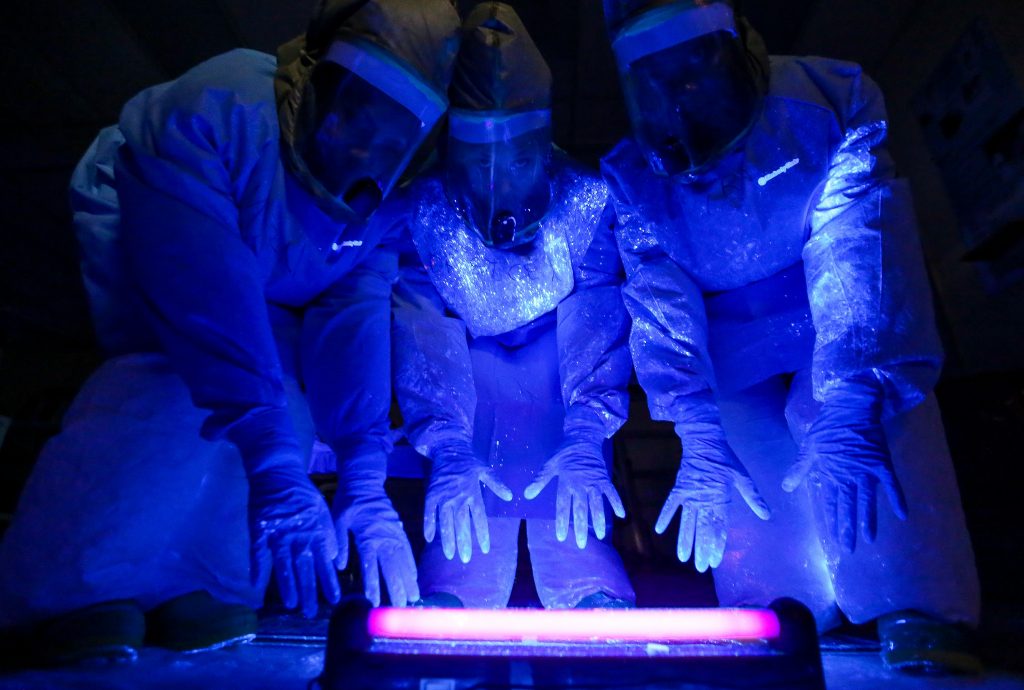December 2013: first case (retrospectively diagnosed) appears in 2 year old in rural Guinea
March 14, 2014: MSF discovers multiple Ebola cases near its malaria clinic in Guéckédou, Guinea
March 22: MSF launches emergency response: doctors, nurses, logisticians and hygiene and sanitation experts to Guinea, sets up isolation units in Guéckédou and elsewhere; sends 33 tons of supplies from pre-packaged Ebola kits in warehouses in Belgium and France
March 25: Guinean Ministry of Health notifies WHO of outbreak; 86 suspected cases and 60 deaths; WHO has confirmed Ebola through testing at research centers in Lyon and Dakar; WHO has deployed multidisciplinary teams to the field “to strengthen surveillance, sensitize and educate the public, manage case and implement appropriate infection prevention and control measures in health facilities and communities affected.”
March 31: MSF reports epidemic of “unprecedented” magnitude in Guinea; cases also reported in Liberia
April 1: WHO states that outbreak is not an epidemic; is “relatively small,” an “outbreak with sporadic cases”; the epidemiology the same as previous outbreaks; ranks Ebola as two on a scale of three (three is most serious health emergency); Sierra Leone reports two cases; Saudi Arabia suspends visas for muslim pilgrims from Guinea and Liberia
April [n/d]: U.S. CDC Epidemic Intelligence Service (EIS) officers begin tracking outbreak in West Africa
April [n/d]: Samaritan’s Purse missionary hospital in New Kru Town slum in Monrovia, “Eternal Love Winning Africa” (ELWA), sets up isolation unit for treating Ebola. No patients arrive until June 11.
April 17: WHO Situation Report classifies the event as a Level 2 Emergency. It states: “There is moderate to high likelihood that the outbreak of EVD in Guinea will require intensive surveillance and response activities for the next 2-4 months.”
May 2: Few new cases in Guinea or Liberia are reported; MSF “remains vigilant”
May 14: WHO reports that “the outbreak seems to be slowing down”
June 20: MSF reports that Ebola outbreak is “totally out of our control”—epidemic is in a second wave; the first time MSF cannot cover patient needs
July 11: MSF reports “race against time” to stop the spread of the disease in Sierra Leone
July 22: Dr. Kent Brantly of Humanitarian’s Purse comes down with Ebola in Monrovia
July 24: WHO upgrades crisis level from two to three
July 20: Brantly and Nancy Writebol treated with Zmapp in Liberia
July 25: First case in Nigeria
July 31: Joanne Liu (head of MSF) urges Margaret Chan (head of WHO) to declare global health emergency
Aug 2: WHO announces $100 million plan to combat epidemic: “This outbreak is moving faster than our efforts to control it”
August 5: USAID establishes Disaster Assistance Response Team (DART) in Liberia to coordinate U.S. response: planning, operations, logistics
August 6: Liberian President Ellen Sirleaf Johnson declares state of emergency: military to enforce blockades; public gatherings banned; schools closed; cremation edict
August 6: U.S. CDC moves Emergency Operations Center (EOC) to “level 1 activation”
August 8: WHO declares PHEIC (public health emergency of international concern); establishes Emergency Committee
August 12: Spanish priest with Ebola dies
August 21: Kent Brantly released from hospital in Atlanta
August 26: Thomas Frieden head of CDC visits Liberia: “we are definitely not at the peak” of the epidemic
Sept 10: Gates Foundation commits $50 million to support Ebola emergency response
Sept 13: Liberia appeals for aid to U.S. to fight Ebola
Sept 16: President Obama announces that U.S. will establish a military command center in Liberia involving 3,000 personnel: “Our troops are going to bring in their expertise in command and control, logistics and engineering, and our armed services are better at that than any organization on earth.”
Sept 20: United Nations establishes UN Mission for Ebola Emergency Response in Ghana
Sept 23: CDC releases best and worst case scenario models for epidemic. In worst case, there could be 1.4 million cases by Jan 20.
Sept 30: homas Eric Duncan tests positive for Ebola in Dallas hospital
Oct 6: Spanish nurse who treated priest tests positive for Ebola
Oct 12: Second health care worker in Dallas hospital confirmed to have Ebola; CDC cites “breach of protocol”
Oct 20: CDC announces new guidelines for health care workers treating Ebola patients
Oct 23: U.S. doctor Craig Spencer of MSF tests positive for Ebola
Oct 24: NY and NJ order quarantine of returning workers; Kaci Hickox of CDC Epidemic Intelligence Service quarantined upon return from Sierra Leone (where she was working with MSF)
